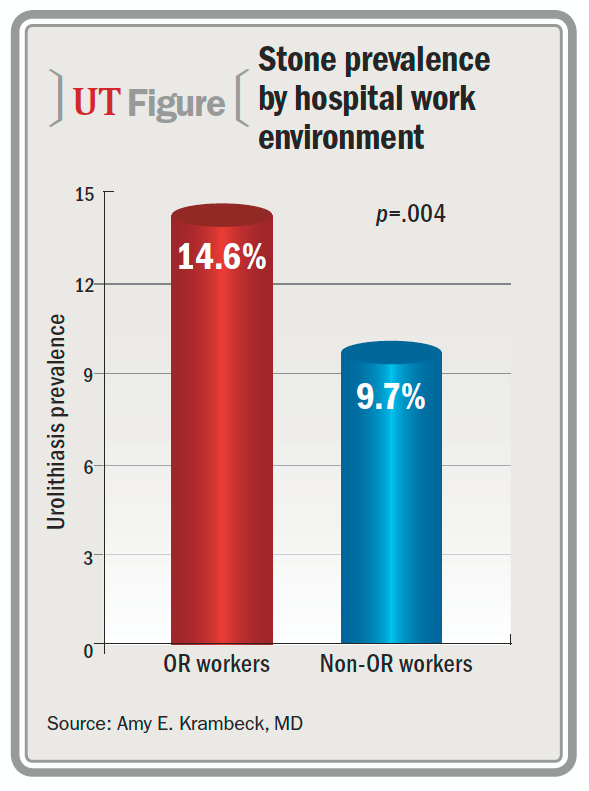Article
High HgbA1c levels, caloric intake boost stone risk
Author(s):
Two separate studies provide insight into a pair of factors-diabetes and changes in the American diet-that may boost the risk of kidney stone formation, including the formation of certain stone subtypes. A third study, meanwhile, suggests that medical professionals who work in operating rooms face a higher risk of stones, possibly because of high stress and low fluid intake.
Madison, WI-Two separate studies provide insight into a pair of factors-diabetes and changes in the American diet-that may boost the risk of kidney stone formation, including the formation of certain stone subtypes. A third study, meanwhile, suggests that medical professionals who work in operating rooms face a higher risk of stones, possibly because of high stress and low fluid intake.
All three papers were presented at the 2013 AUA annual meeting in San Diego.
In the diabetes study, researchers sought to determine whether there’s a connection between blood levels of hemoglobin A1c (HgbA1c), a measure of long-term control of type 2 diabetes, and the composition of kidney stones.

“It’s been known for some time that diabetics are more prone to stone formation overall,” said lead author Sara Best, MD, assistant professor of urology at the University of Wisconsin, Madison. It appears that several related factors-including metabolic syndrome and obesity-combine with diabetes to affect urine composition and boost the risk of stones, she said.
Diabetics more prone to uric acid stones
The study confirms existing suspicions that diabetics are more prone to have uric acid stones. In the cohort, 107 stone formers with diabetes mellitus (DM) were more likely to have ≥50% uric acid stones than patients without diabetes (20% and 5%, respectively, p<.0001) and less likely to have brushite stones (0% in DM vs. 4% in non-DM, p=.019).
More important, the study found that poorer diabetes control, as suggested by higher HgbA1c levels, appears to boost the risk of uric acid stones.
In analyzing subtype stone compositions (<50%), patients with stones containing any uric acid had higher mean HgbA1c than those with pure calcium oxalate calculi (5.9% vs. 6.7%, p=.02). Patients who managed their diabetes with oral hypoglycemic medications had more uric acid stones than those who relied on other strategies (34% vs. 10%, p=.005).
Overall, Dr. Best said, diabetics still form more calcium stones than uric acid stones. But, as the study shows, they’re more likely to form uric acid stones than are other patients.
Dr. Best said urologists should take special care to consider the possibility that a diabetic patient-especially one with a poorly controlled condition-may have uric acid stones that are harder to detect via x-ray. And, she said, urologists should be aware that they can help reduce the risk of stones in patients by urging them to better control their diabetes.
This fits into the trend in medicine of taking a “whole-body approach” rather than treating conditions separately, she said.
In a related study, Shubha K. De, MD, and Manoj Monga, MD, of Cleveland Clinic examined federal statistics to track the American diet and rates of stone disease from 1974 to 2010.
Dr. De and Dr. Monga found that increases in stone prevalence correlated strongly with rises in total daily calories (Rho: 0.96, CI: 0.86-1.00, p<.001), fat grams (Rho: 0.79, CI: 0.55-1.00, p<.001), protein ounces (Rho: 0.85, CI: 0.67-1.00, p<.001), and fruits and vegetables (Rho: 0.73, CI: 0.49-0.97, p<.001).
Several foods also strongly correlated with stone prevalence, including dark green vegetables (0.98), flour/cereal products (0.90), corn products (1.00)-including high fructose corn syrup (0.79)-and added sugars (0.72).
High stone prevalence among physicians
In the third study, subsequently published in Urolithiasis (2013; 41:327-31), researchers from Mayo Clinic, Rochester, MN sought to determine whether certain kinds of medical employees suffer from higher rates of urolithiasis. The authors, led by Amy E. Krambeck, MD, analyzed the results of an electronic survey of 3,921 randomly selected employees at their institution.

The prevalence of urolithiasis was 10.9% (196) among all the respondents, while those who worked in an operating room had a higher prevalence of stone disease compared to those who work elsewhere (14.6% [64/439] vs. 9.7% [132/1,363]; p=.004). Physicians had an even higher rate and reported higher stress and significantly less fluid intake.UT
Subscribe to Urology Times to get monthly news from the leading news source for urologists.

















